Book contents
- Frontmatter
- Contents
- Preface
- Acknowledgements
- Roadmap
- 1 What makes CDMA work for my smartphone?
- 2 How does Google sell ad spaces?
- 3 How does Google rank webpages?
- 4 How does Netflix recommend movies?
- 5 When can I trust an average rating on Amazon?
- 6 Why does Wikipedia even work?
- 7 How do I viralize a YouTube video and tip a Groupon deal?
- 8 How do I influence people on Facebook and Twitter?
- 9 Can I really reach anyone in six steps?
- 10 Does the Internet have an Achilles' heel?
- 11 Why do AT&T and Verizon Wireless charge me $10 a GB?
- 12 How can I pay less for each GB?
- 13 How does traffic get through the Internet?
- 14 Why doesn't the Internet collapse under congestion?
- 15 How can Skype and Bit Torrent be free?
- 16 What's inside the cloud of iCloud?
- 17 IPTV and Netflix: How can the Internet support video?
- 18 Why is WiFi faster at home than at a hotspot?
- 19 Why am I getting only a few % of the advertised 4G speed?
- 20 Is it fair that my neighbor's iPad downloads faster?
- Index
- Notes
14 - Why doesn't the Internet collapse under congestion?
Published online by Cambridge University Press: 05 November 2012
- Frontmatter
- Contents
- Preface
- Acknowledgements
- Roadmap
- 1 What makes CDMA work for my smartphone?
- 2 How does Google sell ad spaces?
- 3 How does Google rank webpages?
- 4 How does Netflix recommend movies?
- 5 When can I trust an average rating on Amazon?
- 6 Why does Wikipedia even work?
- 7 How do I viralize a YouTube video and tip a Groupon deal?
- 8 How do I influence people on Facebook and Twitter?
- 9 Can I really reach anyone in six steps?
- 10 Does the Internet have an Achilles' heel?
- 11 Why do AT&T and Verizon Wireless charge me $10 a GB?
- 12 How can I pay less for each GB?
- 13 How does traffic get through the Internet?
- 14 Why doesn't the Internet collapse under congestion?
- 15 How can Skype and Bit Torrent be free?
- 16 What's inside the cloud of iCloud?
- 17 IPTV and Netflix: How can the Internet support video?
- 18 Why is WiFi faster at home than at a hotspot?
- 19 Why am I getting only a few % of the advertised 4G speed?
- 20 Is it fair that my neighbor's iPad downloads faster?
- Index
- Notes
Summary
A Short Answer
Principles of distributed congestion control
When demand exceeds supply, we have congestion. If the supply is fixed, we must reduce the demand to alleviate congestion. Suppose the demand comes from different nodes in a network, we need to coordinate it in a distributed way.
As the demand for capacity in the Internet exceeds the supply every now and then, congestion control becomes essential. The timescale of congestion control is on the order of ms, in contrast to shaping consumer behavior through pricing in Chapters 11 and 12. The need for congestion control was realized in October 1986, when the Internet had its first congestion collapse. It took place over a short, three-hop connection between Lawrence Berkeley Lab and UC Berkeley. The normal throughput was 32 kbps (that is right, kbps, not the Mbps numbers we hear these days). That kind of dial-up modem speed was already low enough, but during the congestion event, it dropped all the way down to 40 bps, by almost a factor of 1000.
The main reason was clear as we saw from the last chapter on routing: when users send so many bits per second that their collective load on a link exceeds the capacity of that link, these packets are stored in a buffer and they wait in the queue to be transmitted. But when that wait becomes too long, more incoming packets accumulate in the buffer until the buffer overflows and packets get dropped.
- Type
- Chapter
- Information
- Networked Life20 Questions and Answers, pp. 309 - 333Publisher: Cambridge University PressPrint publication year: 2012



